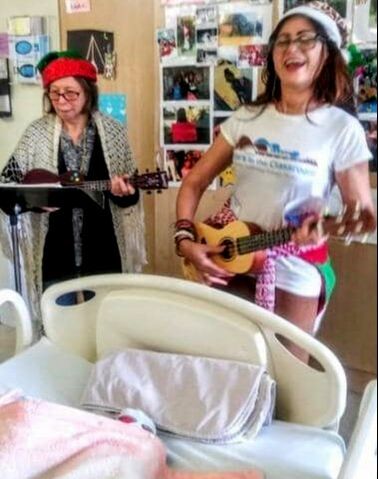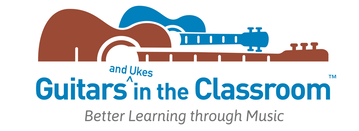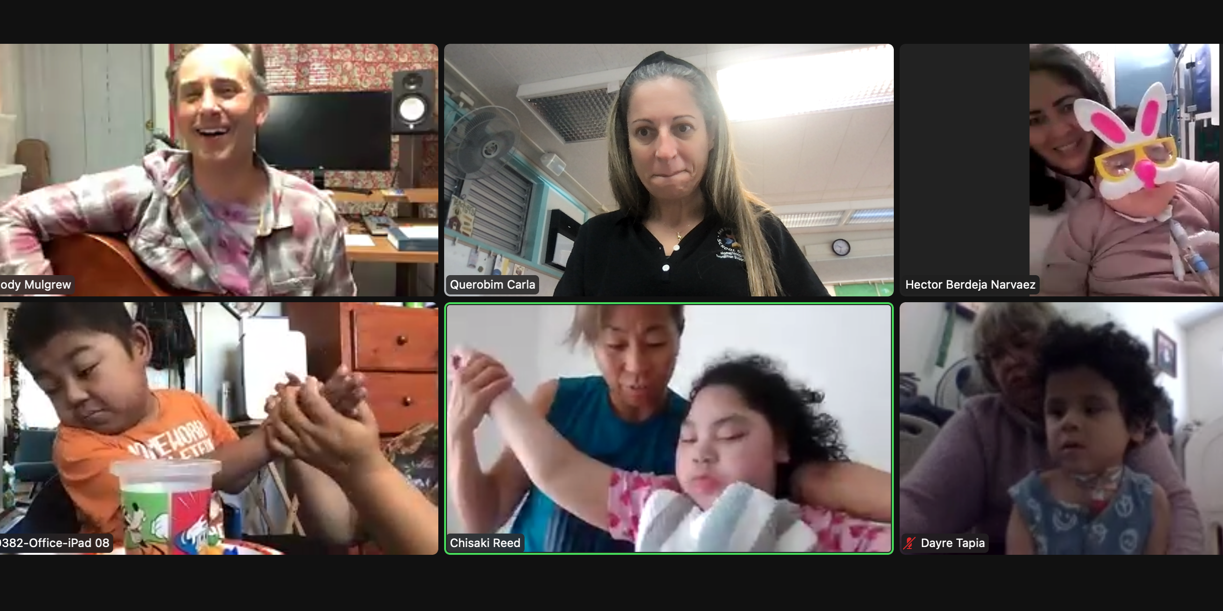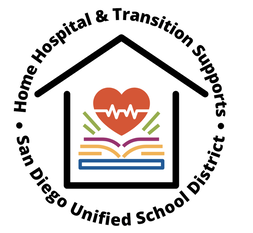 HOME HOSPITAL FAMILY MUSIC HOUR IS CHANGING LIVES Parents and Students in San Diego's Home Hospital Programs Are Joyfully Jamming! GITC is grateful and excited to be bringing authentic, inclusic music making to homebound and hospitalized children this school year in partnership with San Diego Unified School District (SDUSD)'s Home Hospital & Transitions Support Programs, (HHTS). Thanks to the leadership of Sylvia Echeverria- an inspired, innovative, and visionary advocate for students whose complex conditions necessitate them learning from their homes or hospital beds. Ms. Echeverria has enthusiastically encouraged her dedicated and compassionate faculty to train with GITC, participating in a number of different opportunities to explore, learn and grow in community. We are most grateful to her! This year, GITC teaching artists and leaders are delivering Saturday workshops, free online courses, and providing individual teaching artist residencies called SSTARs, as well as leading collaborative music making classes in several HHTS programs. Today we are sharing a bit about our STARRs and the GITC Family Music Hour. The magic ingredient in both of these programs has proven to be bringing HHTS teachers, students, and parents into music-making and musical learning together, so music can become a meaningful and joyful way for everyone to connect and communicate throughout the days and weeks. Music is becoming a shared language. Since early 2022, San Diego home hospital teachers have been attending multiple GITC trainings, learning to work with body percussion, chanting, singing, group drumming, percussion instruments, ukuleles, guitars, music apps, speech production devices, kazoos, slide whistles, and Casio keyboards! Several HHTS teachers have also participated with GITC in specialized teaching artist residencies we call SSTARs, an acronym for Single Skill Teaching Artist Residencies. The 2022-2023 school year is special because for the first time, our home school district, San Diego Unified School District is fully supporting this endeavor with special funding, thanks to GITC's impact on student attendance rates in GITC classrooms. HOW DID THIS START? GITC started developing adaptive music and home hospital work, quietly, in 2016. Our reach into Home Hospital education is part of our initiative called AMAISE (pronounced "amaze"). The acronym stands for Adaptive Music for Achievement in Inclusion and Special Education. AMAISE launched in an effort to bring authentic musical inclusion to students wherever and however they learn. We started exploring possibilities in special education classrooms in San Diego, and home hospital settings in Los Angeles. Mr. Jody, leader of the Family Music Hour, started with us in San Diego classrooms at that time. We are extremely grateful to our early funders and partners in this work, including Karen and Stephen des Jardins, the NAMM Foundation, the Nordson Foundation, and the Kennedy Center's Office of Very Special Arts. SSTARs LED THE WAY TO FAMILY MUSIC HOUR GITC SSTAR residencies connect an HHTS teacher and one of their students, along with that student's designated Home Music Helper (a parent, family member, or caregiver), and a GITC AMAISE-ing teaching artist, so everyone can learn and develop musical connection and communication together. Our teaching artist pairs with the HHTS teacher to design weekly learning experiences which are then facilitated with the student and their HMH. This dedicated team works together every week, as health permits, focusing exploratory and strategic music making to help the teacher, HMH, and student find ways to work towards accomplishing important personal goals. These can be physical, cognitive, behavioral, academic, and/or social-emotional. Even when we aim to address one goal, two or three others are accomplished as well. Everyone gets instrumental experience including developing physical supports such as holding, moving together, providing hand-over-hand assistance, and using special grips and accessories to create sound. The results have been incredibly moving! Students who initially didn't open their eyes or show much response during regular classes have responded powerfully to making music. Students are alert and connecting. Some who have not articulated sounds are vocalizing, and students who had been inactive in their wheel chairs are making an effort to sitting up, leaning in, reach for, and play an instrument. For a child with extreme medical and physical conditions, these are very significant improvement. The parents are growing, too. They are learning to play ukulele, to sing to and with their students, and to access music through a variety of instruments which are delivered to each participating family at home at the start of any SSTAR. These instruments are now in heavy rotation as parents are spontaneously connecting and guiding their children through music. From these STARRs, Family Music Hour was born. Based on the stunning impact of the SSTARs, Ms. Echeverria and her phenomenal colleague Carola Querobim recognized the potential importance of getting the family groups together for a weekly class via Zoom. Calling it Family Music Hour makes everyone feel welcome. Each Friday these gatherings, led by Mr. Jody, cultivate and nurture exuberant expressions of caring joy, hope, individuality, and connection between children, parents, and families- all through the shared experience of making music. Mr. Jody recently shared,"One of our long-time participants turned five this year, and is set to attend school with his peers in the classroom, which is a big deal on its own. Last year, this student's participation with the group was mostly confined to self-soothing behavior on his keyboard. In his most recent sessions, he has been using a communication device to "say/sing hello" to his friends in the group, and to express preferences for songs and instruments! Also, when the group is prompted to say hello using a gesture or instrument, he takes the initiative and grabs his guiro to be ready to play when it's his turn. The amount of expressive language that this student is now bringing to the Family Music Hour is a joy to see, and his improvement underscores the opportunities that our music and language routines provide students for expressing themselves." THE BACKSTORY: WHERE OUR HOME HOSPITAL WORK BEGAN The photo to the right was taken in 2017 at All Saints Hospital in LAUSD where teaching artist Ana Robles, right, trained the nursing staff and the teachers to lead music each day with the children in residence at All Saints Hospital. She often led groups of children in adaptive music there, as many as 10 children at a time, with staff members playing and singing along. Talk about spreading joy! CARLSON HOME HOSPITAL SCHOOL The story of how we began serving in Home Hospital programs goes back to 2016, when GITC teaching artists in Los Angeles Unified School District (LAUSD) first became partners and coaches with an amazing group of home hospital and special educators at the Carlson Home Hospital School (CHHS), who travel around the largest district in California to bring learning to students who are too medically fragile, physically dependent on machines, severely disabled, or ill to attend school in person. We HIGHLY recommend you click on the Carlson Home Hospital School website and watch the documentary found on the left side of their homepage to get a clear understanding of the children who need and deserve to receive these special services. In the history of CHHS, our organization was the first arts provider to venture with them into students' homes and hospitals. GITC is grateful to Margaret Olivares-Gilkyson, now Principal of CHHS, for her vision and dedication, to all participating HHTS teachers who learned to lead adaptive music with us, and to GITC teaching artists Ana Robles, Shiri Goldsmith, and Kristen Herbert for welcoming the Home Hospital teachers and students into their hearts and work with GITC! Donors made all of this possible. At first our efforts were entirely exploratory, and we approached the work by placing our faith in the power of music to transcend barriers, touch hearts, and open minds. We didn't know what might work, so our teaching artists began bringing a wide variety of instruments to the children. We adapted ukuleles so they could be strummed safely, held securely, or stabilized on wheel chair trays and tables if students could sit up. Not only did music deliver on its promise, children in the program participated and benefited in amazing and liberating ways. This approach still characterizes the work we do today, and any educator or paraprofessional working with students who might benefit from adaptive music is welcome to join us for free. Our newest virtual course, focusing on physical adaptations and teaching practices, begins the week of January 23, 2023! This training, like all GITC training, is supported by donations and grants. COMING SOON: AMAISE-ing SATURDAYS 2023 Interested in learning with us in person? Please stay tuned for exciting monthly Saturday morning workshops for special educators and home hospital teachers in a series we are calling AMAISE-ing Saturdays! We'll post at the website and in socials about this opportunity soon. CONTRIBUTE TO THE CAUSE? If you or someone you know might like to contribute to our Home Hospital programs, there are many ways to help. Donations can be made directly through this website in one of our Matching Campaigns throughout December, or sent to our secure mailbox at 1286 University Ave, #389, San Diego, CA 92103. In addition, here is specific link to our online fundraiser on GlobalGiving.org to fund musical access for medically fragile children. We truly appreciate your support! If you know of an educator who might like to participate in AMAISE with us, we hope you'll share this blog, and give them our main email address, [email protected] Thanks so much for reading, and for joining us in our musical outreach and adventures spreading the love,
0 Comments
Leave a Reply. |
BlogArchives
June 2024
Categories
All
|
Copyright © 2024 Guitars In The Classroom. All rights reserved.




 RSS Feed
RSS Feed